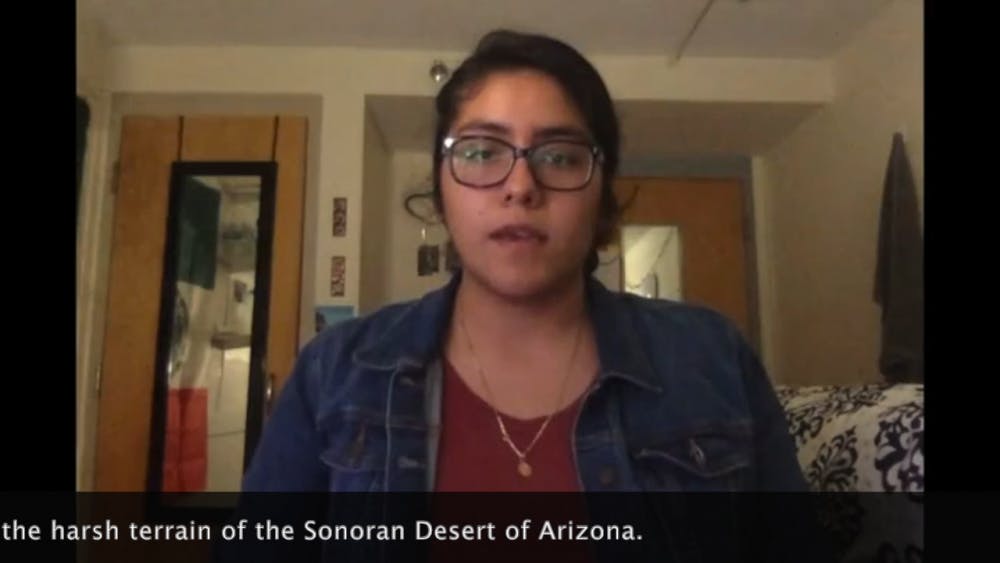The journey from Central America across the southern border of the United States is a frequently traveled path, but its dangers are enormous, and migrants die every year attempting to cross the frontier. Middlebury’s “Hostile Terrain 94” project is a video compilation of members of the community paying tribute to those who have died crossing the U.S.-Mexico border in southern Arizona.
The video is part of the “Hostile Terrain 94” project, directed by Jason De León, a professor of anthropology at UCLA. De León serves as the director of the Undocumented Migration Project, which visually catalogues migrant deaths that occurred as a result of the the U.S.’s 1994 Prevention Through Deterrence policy. The policy took advantage of the strategically increased border patrol presence in urban areas along the southern border, redirecting migration routes through the Sonoran Desert in Arizona to let the harsh environment and hostile terrain do the work of border patrol agents in deterring and preventing migrants from crossing.
The 18-minute video features members of the Middlebury community reading the name, age, reporting date and cause of death of migrants who perished while attempting to cross the border. While most people showed their face, some remained anonymous and spoke with a black screen.
The majority of the deaths are due to “exposure to the elements.” Throughout the video, text ran across the bottom of the screen reading: “As a result of the U.S. border enforcement strategy — Prevention Through Deterrence — at least 3,200 migrants have died while attempting to cross the harsh terrain of the Sonoran Desert of Arizona.”
“I think a lot of Americans just aren’t aware of the involvement that the U.S. has in perpetrating violence against migrants,” Stephanie Soriano-Cruz ’21, one of the students who helped organize the video, said. “The U.S has just distanced itself or deflected blame and placed it on the migrants themselves as if they’re responsible for their own deaths.”
Soriano-Cruz said that she wanted to raise awareness about the violent nature of the U.S.’s strategies in deterring migration.
The idea for the video was conceived when Rachel Joo, an associate professor of American Studies, taught De León’s book “The Land of Open Graves” in her course titled Immigrant America.
“It’s really a book that breaks all sorts of boundaries in terms of disciplines and incorporation of photography and art and academic tests,” Soriano-Cruz said. “It’s an incredibly powerful book about death on the US Mexico border, death of migrants, and who is to blame and what factors contribute to deaths.”
Many of her students were moved by the book and wanted to bring De León to campus to speak. Their wish came true in the fall of 2019 when he came to Middlebury, led several events and invited the school to join his project.
“Jason De León was interested in making it a very visible statement that would contribute to the discourse around immigration up to the election,” Joo said. “He wanted immigration to be a bigger issue than it has been in this last year. It’s been mostly about the pandemic, and obviously that affects everyone, but a lot of the issues around immigration, like these 545 children who’ve been taken from their parents whose parents can’t be located, that was just a blip.”
In October, a report revealed that the parents of more than 500 children separated from their families at the border could not be found.
In a world without Covid-19, the “Hostile Terrain 94” is a traveling visual exhibit. Participants receive a name of a migrant who died, fill out a toe tag similar to those that identify the bodies found in the Sonoran Desert and pin it to the location where their body was found on a large map.
“It becomes this 3D artwork. It really gives you an understanding of the lives that are lost,” said Trinh Tran, assistant professor in anthropology and education studies. “Because it’s individuals who are getting the names of individual migrants and writing it down, I think it starts to sink in, the scale and the enormity of the loss.”
Joo assembled a group of students including Alondra Carmona ’21, Christine Nabung ’22, Ariana Rios ’21, Soriano-Cruz ’21, and Tran. Tran has taken over the project this year while Joo is on sabbatical. Around 180 institutions, including schools, museums and libraries, are participating in the project. Although some places decided to create a Covid-19-safe way to create the toe tag exhibit, Middlebury decided to delay the hands-on component and create a video in the interim.
“I think during this time of Covid, when our freedom of movement is so limited, this project is really important because maybe now more than ever we can understand why the right to movement is so important, and how some people don’t enjoy those rights that we have,” Tran said. “Not only do they not enjoy those rights, but they will pay literally the highest price, which is their lives, in order to get that right to mobility.”
On Oct. 15, the Dean of Students sent an email to Middlebury students detailing the project. It informed members of the community that they could email Hostile Terrain in order to receive a name and record a clip for the larger video. Tran has access to the Undocumented Migration Project’s database of names and assigned them to individuals who reached out. On Oct. 28, the group, which is affiliated with Juntos, screened the video at Crossroads Cafe from 12-4 p.m.
“There's that Middlebury bubble we talk about a lot where it’s easy for us to just stay on campus and not really think about what’s going on in the community, but this impacts students on this campus and folks in the community directly, and we just don’t think about those things,” Rios said.
As a first-generation Mexican-American, this project is personal for Rios. Her father, who crossed the U.S.-Mexico border in the 90s, was very excited about Middlebury’s involvement and submitted a video to the larger project.
“He was lucky and he was able to make it across, but there are thousands of people who don’t,” she said.
“The purpose of this project is to give names to the people who have crossed over. A lot of the time we don’t get to see and hear these names or these people who have lost their lives,” said Carmona, one of the other student organizers.
The team hopes to show the video again in the future, possibly projected on Mead Chapel, and make the video accessible on the internet.

Katie Futterman '24 (she/her) is a Managing Editor.
Katie previously served as a News Editor and Staff Writer. This past summer, she was a news intern at Seven Days, and she held the same position at the Addison Independent the prior summer. In her free time, she loves to read, write, and bask in the sun.




